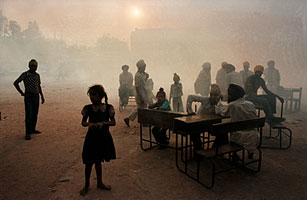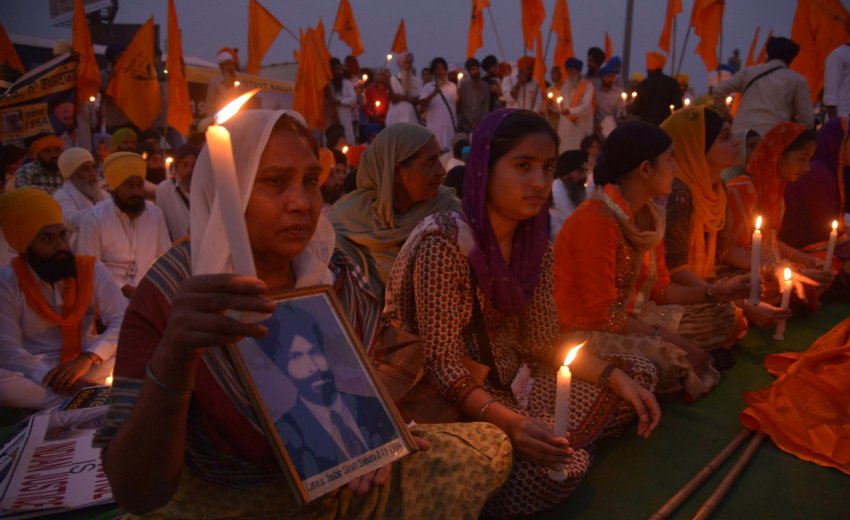25 years ago history was made for several different reasons. Today, as we reflect on the invasion, on the assassination, and on the massacres, we come across multiple news articles which provide information and commentary on the events of that year. I wanted to take the time to document and highlight these articles as they’re worthy reads in providing information to readers around the world. I encourage you to read these pieces – they are vital to our understanding and they will inform Sikhs and non-Sikhs alike about events in our history.
 1. TIME magazine featured an article titled, “India’s 1984 Anti-Sikh Riots: Waiting for Justice.” Our readers have previously argued against
the use of the word “riot” and suggested that “genocide” is the more
fitting description of what happened. Regardless, this is an important
article which discusses the often silent victims of 1984 – the widows
and their children and the impact the events (and lack of justice) has
had on their future.
1. TIME magazine featured an article titled, “India’s 1984 Anti-Sikh Riots: Waiting for Justice.” Our readers have previously argued against
the use of the word “riot” and suggested that “genocide” is the more
fitting description of what happened. Regardless, this is an important
article which discusses the often silent victims of 1984 – the widows
and their children and the impact the events (and lack of justice) has
had on their future.
The widows’ colony in Tilak Vihar is a cheaply built and neglected cluster of homes, which were given by the government to hundreds of women and their children who survived what have become known as the anti-Sikh riots of 1984. But as the grim event’s 25th anniversary nears at the end of this month, crime, addiction and prostitution have taken root in what was supposed to be a survivors’ safe haven. Residents say this is because of the damage to the mental health of children who were witness to their parents’ and siblings’ murders and who grew up in impoverished homes and weren’t given any medical help — physical or mental — for their problems. [link]
Of note: for the 25th anniversary of the event, advertisements by Ensaaf — showing an old woman wiping away her tears, with the words, “25 years ago, our loved ones were burned alive in front of our eyes,” and in the next line, “Why has India, the world’s largest democracy, denied us justice?” — are scheduled for the month of November in the San Francisco Bay Area’s transit system!
2. The BBC has an article titled, “Indira Gandhi’s death remembered” with a focus on the massacres that followed Indira Gandhi’s assassination.
As we walked through this implausible slaughter in the light of hurricane lamps provided by some residents, the complete silence despite the large mob surrounding us was eerie. No one spoke and nothing, except the bizarre, dancing shadows moved during this surrealistic interlude. Even one of the only survivors – a young polio-afflicted mother – holding her new born in her arms gazed sightlessly upon us. Her blank look momentarily changed into one of abject terror as we bent down to take her child to whom she fiercely clung. She probably took us to be the butchers who had massacred her entire family piled up high in the room behind her. A whimper led us to a barely conscious young Sikh, hiding under a heap of bodies, his slashed stomach wrapped crudely around with a turban. [link]
The sad reality? Of the 2,733 officially admitted murders, only nine cases have so far led to the conviction of 20 people in 25 years; a conviction rate of less than 1%.
3. UK-based The Guardian reports on “No Justice for India’s Sikhs.” In a personal account, the journalist speaks of her memories of 1984 and the lack of accountability which still permeates the Indian government.
Two and a half decades later, the language used to describe that night remains as blurry as ever. Was it a genocide? Who drew up lists of identification? Why did the police disappear or intervene to protect the mobs rather than the victims? Did Rajiv Gandhi, the incumbent prime minister, encourage the murders through his statements on the radio? Did members of Congress incite the killings? Why did ministers fail to act when they had been warned by the army that a “holocaust” might be unleashed that very night? Who kept the army at bay? In short, was this state-sponsored violence of the order that led to another decade of brutality in which some 10,000 Punjabi Sikhs, mostly men, were “disappeared” by the state? [link]
4. In another Guardian piece, “Garden murder that sparked a Delhi pogrom” describes one correspondent’s memories of the events that followed Indira Ghandi’s assassination.
In retrospect, one of the most interesting things is how quickly people learned to behave in new ways. The looters might have been looting all their lives, the youths who manned the road barriers might have served apprenticeships in stopping cars and searching them, the mobs who poured kerosene over dead or dying Sikhs did so, according to witnesses, quite matter-of-factly. Somewhere in south Delhi I came across a group setting fire to a Sikh-owned furniture factory and asked them what they thought they were doing. “Setting fire to a Sikh furniture factory,” one man said, as though it was the most natural thing in the world. [link]
5. Finally, Jaskaran Kaur, co-director of Ensaaf, wrote an opinion piece in the San Jose Mercury News describing the role Bay Area residents can play in helping to seek justice for the massacres in India. She speaks about the Sikh massacres as well as the violence against Muslims in Gujarat and Christians in Orissa.
Scars linger for survivors who have rebuilt their lives in the Bay Area. While local Sikhs will reflect on the 25th anniversary of the massacres this week, the vast majority of their neighbors will be unaware of the grief gripping the community. [link]
Read and be informed!

